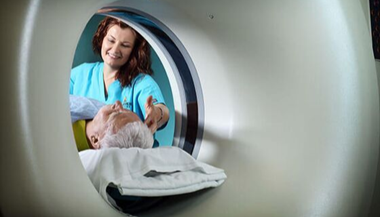CT Enterography
What is computed tomography (CT) enterography?
CT enterography is an imaging test that uses CT imagery and a contrast material to view the small intestine. The procedure allows your healthcare provider to determine what is causing your condition. He or she can also tell how well you're responding to treatment for a health issue, such as Crohn's disease.
A computerized tomography scan, or CT scan, is a type of X-ray that uses a computer to make cross-sectional images of your body.
CT enterography is a quick, accurate, and painless procedure.
Unlike regular X-ray images, CT enterography is able to provide detailed images of tissue and structures, such as bone and blood vessels.
Why might I need CT enterography?
This test is typically done to find:
- Inflammation
- Tumors
- Bowel obstructions or abscesses
- The source of bleeding
- Location and severity of Crohn's disease
What are the risks of CT enterography?
CT enterography uses X-ray technology with as little radiation exposure as possible. Talk with your healthcare provider about this risk.
You should let your healthcare provider know if you have any allergies, particularly if you have had an allergic reaction to contrast materials or dyes before.
If you are pregnant or think that you may be pregnant, tell your healthcare provider.
There may be other risks, depending on your specific medical condition. Be sure to discuss any concerns with your healthcare provider before the procedure.
How do I get ready for CT enterography?
- Be sure to let your healthcare provider know about any recent infections or illnesses, as well as any chronic conditions that you have. These include diabetes, asthma, heart disease, thyroid problems, and kidney disease.
- You will be asked to stop eating and drinking about 3 hours before the procedure. We encourage you to drink clear liquids before your test.
- If receiving general anesthesia, please refer to the specific instructions given to you by your provider.
- You may wear a gown during CT enterography, but you should wear comfortable, loose-fitting clothes the day of the procedure.
- Remember to remove all jewelry and other metal objects. Ask whether you need to remove any hearing aids and metal dental devices that can be taken out.
What happens during CT enterography?
- Before the test, you will need to drink a few glasses of liquid over the course of about an hour. The liquid includes the contrast material that will help the radiologist better see your small intestine on the CT scan. Instead of drinking a contrast solution, you may have it given by enema.
- After you have finished drinking the contrast liquid solution, you will lie on a table, probably on your back. As you lie on the table, it will slowly move through the CT scanning machine to capture the X-ray images. While the scanning is being performed, a different type of contrast will also be injected into a vein in your arm.
- You will likely be asked to hold your breath for brief periods while the machine is scanning. The procedure is painless, but you will have to lie still for a period. This could be uncomfortable for some people.
What happens after CT enterography?
The CT enterography procedure doesn’t cause any lasting side effects. You won’t need recovery time because the test doesn’t require any incisions or sedation. You can resume your regular activities as soon as the procedure is completed. Talk to your healthcare provider if you are breastfeeding about whether to delay breastfeeding for 1 to 2 days or not. Current information on this is conflicting.
A radiologist will review your test results and send them to your healthcare provider. You will then have a follow-up phone call or visit with your healthcare provider to discuss the results and next steps.
Next steps
Before you agree to the test or the procedure make sure you know:- The name of the test or procedure
- The reason you are having the test or procedure
- What results to expect and what they mean
- The risks and benefits of the test or procedure
- What the possible side effects or complications are
- When and where you are to have the test or procedure
- Who will do the test or procedure and what that person’s qualifications are
- What would happen if you did not have the test or procedure
- Any alternative tests or procedures to think about
- When and how will you get the results
- Who to call after the test or procedure if you have questions or problems
- How much will you have to pay for the test or procedure





